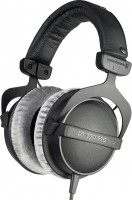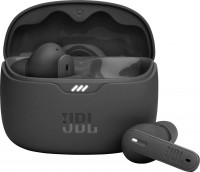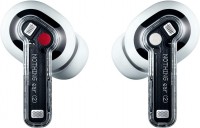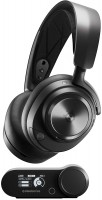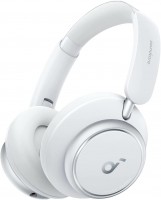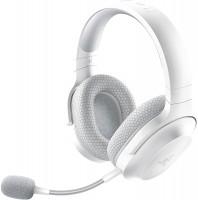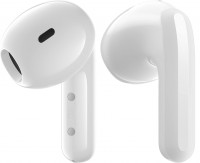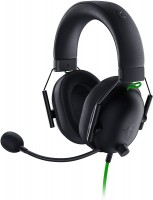Headphones Motorola
All Headphones Advanced filters → |
You might be interested in
Articles, reviews, useful tips
All materials
Always with you: Portable gadgets for daily use
Everyday gadgets that are useful on the road and easy to carry in your backpack

What to give a girl?
Note to guys: variable gift ideas for girlfriends

TOP 5 great studio headphones for audiophiles
Choosing the right option to comfortably listen to music at home

How to choose a soundbar?
Is a soundbar the best solution for home theater or a compromise? How to select the appropriate soundbar. Complete guide.

Good TWS headphones with active noise cancellation
TWS headphones with a noise reduction system that ensures clear voice when communicating and rich music compositions

TOP full-size on-ear headphones for lovers of sophisticated sound
High-end on-ear headphones from AKG, HiFiMan, Beyerdynamic, Philips and Sennheiser for home listening
Headphones: specifications, types
Show all
Features
This parameter is indicated only for specialized models that are not related to “ears” for general use. Nowadays, in headphones you can find the following specialization options: gaming, for active sports, office, monitor(aka studio), for DJs, for sleep. Here is...a more detailed description of these varieties:
- Gaming. Headphones designed primarily for use in games - primarily with PCs and laptops (a separate type is available for consoles, see below for details). Externally they stand out primarily due to their design - usually quite bright and aggressive. Most of these models have an overhead design, most often in a full-size “Over Ear” format (see “Design”) - this provides maximum immersion into the gaming. There are other design options, but much less common. An almost mandatory part is a microphone - for voice communication in online games. In addition, most multi-channel models fall into this category (see “Sound”) - such sound is most important for games.
— For active sports. Headphones good for sports. Such devices must, firstly, have additional fixation in the ears or on the head so as not to change their position during active movements; secondly, don’t be afraid of sweat (and ideally, rain, snow and other precipitation). With rare exceptions, headphones for active sports do not have a wire that could create inconvenience when moving. Sports headphones include earbuds models, earbuds, and some on-ear headphones. The key character traits they share are a secure fit and at least some degree of IP water resistance (see "Ingress Protection (IP)").
- Office. Office headphones are designed for consultants, support operators and other employees who constantly have to deal with voice communications over the phone or the Internet. Accordingly, one of the main features in such models is the presence of a microphone. Also among office headphones, models for one ear are very popular (see “Sound - mono”), which allow you to hear both the interlocutor on the line and the surrounding environment at the same time. Many “ears” for this purpose use a USB connection (see “Connection”) - in the expectation that inexpensive office computers may not have specialized audio outputs at all. In this case, a small control panel for working with IP telephony can be provided directly on the USB plug; it allows, in particular, to accept and reject calls. There are also wireless models (usually with a connection via a radio channel, less often via Bluetooth), as well as specialized solutions connected to telephone sets using specific connectors.
— Monitor (studio). Headphones designed for use in professional sound recording and when setting up audio equipment. They are made only wired. However, the key feature of such models is different: they have the most even frequency response, which gives almost the same sound volume in all frequency bands, and a wide operating range, often exceeding the limits of frequencies audible to humans. Thanks to this, headphones for this purpose are able to clearly identify all the flaws in the sound signal - including nuances that are not noticeable on traditional “ears”; Such capabilities are indispensable in professional work with sound. On the other hand, for the same reason, there is no point in using monitor models for everyday listening to music: they not only reveal various shortcomings of the recording, but also give the sound a specific coloring that is unusual and even unpleasant for the average user.
- For DJ. Headphones originally intended for use by professional DJs when mixing tracks. In many ways they are similar to the monitor ones described above - in particular, they have a very smooth frequency response, providing the most reliable sound, and a wide frequency range. In addition, DJ headphones are usually made in a closed acoustic design and generally have high quality sound insulation, which allows you to maintain good audibility even in quite noisy environments.
- For sleep. Miniature headphones of a special anatomical shape, which allows you to calmly fall asleep lying on your side without discomfort in the ear. To reduce ambient noise levels, they are usually designed with passive noise reduction. These headphones can be used both for listening to music and for broadcasting white noise, nature sounds or waves. Advanced models also monitor sleep quality, and the alarm function turns on a wake-up melody at the appointed time. Such headphones are often called electronic earplugs.
- Gaming. Headphones designed primarily for use in games - primarily with PCs and laptops (a separate type is available for consoles, see below for details). Externally they stand out primarily due to their design - usually quite bright and aggressive. Most of these models have an overhead design, most often in a full-size “Over Ear” format (see “Design”) - this provides maximum immersion into the gaming. There are other design options, but much less common. An almost mandatory part is a microphone - for voice communication in online games. In addition, most multi-channel models fall into this category (see “Sound”) - such sound is most important for games.
— For active sports. Headphones good for sports. Such devices must, firstly, have additional fixation in the ears or on the head so as not to change their position during active movements; secondly, don’t be afraid of sweat (and ideally, rain, snow and other precipitation). With rare exceptions, headphones for active sports do not have a wire that could create inconvenience when moving. Sports headphones include earbuds models, earbuds, and some on-ear headphones. The key character traits they share are a secure fit and at least some degree of IP water resistance (see "Ingress Protection (IP)").
- Office. Office headphones are designed for consultants, support operators and other employees who constantly have to deal with voice communications over the phone or the Internet. Accordingly, one of the main features in such models is the presence of a microphone. Also among office headphones, models for one ear are very popular (see “Sound - mono”), which allow you to hear both the interlocutor on the line and the surrounding environment at the same time. Many “ears” for this purpose use a USB connection (see “Connection”) - in the expectation that inexpensive office computers may not have specialized audio outputs at all. In this case, a small control panel for working with IP telephony can be provided directly on the USB plug; it allows, in particular, to accept and reject calls. There are also wireless models (usually with a connection via a radio channel, less often via Bluetooth), as well as specialized solutions connected to telephone sets using specific connectors.
— Monitor (studio). Headphones designed for use in professional sound recording and when setting up audio equipment. They are made only wired. However, the key feature of such models is different: they have the most even frequency response, which gives almost the same sound volume in all frequency bands, and a wide operating range, often exceeding the limits of frequencies audible to humans. Thanks to this, headphones for this purpose are able to clearly identify all the flaws in the sound signal - including nuances that are not noticeable on traditional “ears”; Such capabilities are indispensable in professional work with sound. On the other hand, for the same reason, there is no point in using monitor models for everyday listening to music: they not only reveal various shortcomings of the recording, but also give the sound a specific coloring that is unusual and even unpleasant for the average user.
- For DJ. Headphones originally intended for use by professional DJs when mixing tracks. In many ways they are similar to the monitor ones described above - in particular, they have a very smooth frequency response, providing the most reliable sound, and a wide frequency range. In addition, DJ headphones are usually made in a closed acoustic design and generally have high quality sound insulation, which allows you to maintain good audibility even in quite noisy environments.
- For sleep. Miniature headphones of a special anatomical shape, which allows you to calmly fall asleep lying on your side without discomfort in the ear. To reduce ambient noise levels, they are usually designed with passive noise reduction. These headphones can be used both for listening to music and for broadcasting white noise, nature sounds or waves. Advanced models also monitor sleep quality, and the alarm function turns on a wake-up melody at the appointed time. Such headphones are often called electronic earplugs.
Console compatibility
License binding of headphones to a specific model of the game console means full compatibility between devices and gives a 100% guarantee that all claimed functions will work. Note that in addition to the stated set-top box, such headphones can be safely used in conjunction with a computer, smartphone and other models of game consoles through suitable connection interfaces. However, the full potential of the headphones is revealed only in conjunction with a cert...ain game console.
Bone conduction
Headphones that work on the principle of bone conduction.
In such models, the emitters are not mounted on (or in) the ear, but on the head not far from the ear (usually in front), and the sound is transmitted to the eardrum not through the ear canal, but through the bones of the skull. The main advantage of this principle of operation is that the ears remain open. Thus, the user can hear well both the music in the headphones and the sounds of the sur...rounding world. In many situations, this is very convenient (for example, in the office or on the beach), and in some situations it is also critical for safety (for example, when riding a bicycle). At the same time, the headphones are compact, quite comfortable, and the sound is quite high-quality and loud (and almost inaudible to others). The main disadvantage of such solutions is the rather high cost.
Another specific type of headphones that use this feature are in-ear models and earbuds (see "Design"), in which the emitters work in a traditional format, and bone conduction is used to transmit the user's voice to the built-in microphone. A similar feature is found in some true wireless devices (see "Type of cable"): the microphone in such models is located far from the mouth, and it is more convenient to transmit voice to it through the bones of the skull, and not in the usual way, through the air.
In such models, the emitters are not mounted on (or in) the ear, but on the head not far from the ear (usually in front), and the sound is transmitted to the eardrum not through the ear canal, but through the bones of the skull. The main advantage of this principle of operation is that the ears remain open. Thus, the user can hear well both the music in the headphones and the sounds of the sur...rounding world. In many situations, this is very convenient (for example, in the office or on the beach), and in some situations it is also critical for safety (for example, when riding a bicycle). At the same time, the headphones are compact, quite comfortable, and the sound is quite high-quality and loud (and almost inaudible to others). The main disadvantage of such solutions is the rather high cost.
Another specific type of headphones that use this feature are in-ear models and earbuds (see "Design"), in which the emitters work in a traditional format, and bone conduction is used to transmit the user's voice to the built-in microphone. A similar feature is found in some true wireless devices (see "Type of cable"): the microphone in such models is located far from the mouth, and it is more convenient to transmit voice to it through the bones of the skull, and not in the usual way, through the air.
Design
In this paragraph, first of all, the method of mount on the ears is specified; according to this parameter, modern headphones are divided into overhead, earbuds, in- ear, glasses and headbands. For on-ear models, the acoustic design (closed, semi-open, open) can also be specified here, as well as the presence of such features as a full-dimensions (over-ear) design...(in the absence of this feature, such headphones are called “on-ear”, or simply on-ears), swivel earcups, auto-adjust headband, or even the mid-2021 trend, Cat Ears. And details such as a rigid headband, behind-the- ear mount, mount on the neck and the ability to fold can be combined with almost any method of placement on the ears (with a few exceptions - for example, on-ear models are not attached to the neck).
Here is a more detailed description of the different ear placement options:
- Overhead. Overhead headphones are called headphones that are located outside the auricles, covering the ear from the side (“regular” overhead models) or completely (full-sized Over-Ear - see below about them). In any case, such models are quite large in dimensions. This, on the one hand, simplifies the creation of headphones with advanced sound characteristics, and also allows you to apply some specific tricks without much difficulty - for example, several emitters or support for multi-channel surround sound. On the other hand, the dimensions of the "ears" complicate the transportation and use on the go. In addition, it is worth considering that most overhead models have a headband, which is why they are poorly compatible with complex hairstyles and some headdresses. Models with rigid temples and behind-the-ear fasteners do not have this disadvantage, but they also have their own specifics (see below).
On-ear headphones can have different acoustic design:
- Intracanal with a rigid shackle. In-ear headphones are laid inside the auditory canals, which allows them to be fixed as securely as possible in the ear and not fall off. The presence of a rigid bow further increases the reliability of fixing the headphones. This type of headphone is well suited for sports. The rigid headband and earbuds design of the sound emitters keep the earbuds securely in place even during intense running.
- Inserts. Also known colloquially as "pills". Similar to earbuds headphones, these headphones are small in dimensions and are placed in the auricle - however, not in the depth of the auditory canal, but at its very beginning, almost outside. This makes the earbuds somewhat simpler in design and cheaper, but it is more difficult to achieve rich sound and advanced acoustic characteristics in them. Such models give a rather low sound insulation, but this can be both a disadvantage and an advantage, depending on the situation. And some headphones of this type have an elongated shape, due to which they sit deeper in the ears and, in terms of their capabilities, can approach earbuds models.
Separately, it is worth noting that earbuds models and earbuds do not use headbands - the headphones are either completely separate or connected with a device such as a rigid headband or neck mount. So these headphones can be worn with almost any hairstyle or headdress without any problems.
— Inserts with a rigid headband. The earbuds are simply inserted into the passage of the auditory canal without penetrating deeply into it. This is not the most reliable way to fix the headphones, but due to the presence of a rigid headband, the earbuds gain a firm fit and a secure fit. The headphones themselves have an open sound path design, and therefore reproduce audio with a noticeable distortion of the original sound signal. But at the same time, the open acoustics scheme allows you to clearly hear what is happening in the surrounding space.
As for additional design features, they can be as follows:
- Full-dimensions Over-Ear. On-ear headphones (see above) in which each cup completely covers the ear and fits snugly to the head. The cups themselves in such models are made quite large and are equipped with characteristic soft "borders" around the perimeter of the inner side - these borders are adjacent to the head, so that the auricle is actually inside the cup. The main advantage of this design is that the headphones (with the right dimensions) practically do not touch the user's ears and do not put pressure on them - this is especially comfortable during prolonged use. In addition, it is easier to achieve high-quality sound insulation in Over-Ear models (although among them it is quite possible to find models with semi-open and even completely open acoustic design). The main disadvantage of such devices is bulkiness and inconvenience in transportation and use on the go. In addition, when wearing glasses, the Over-Ear cups usually press on the temples from the sides, which can cause discomfort.
- Auto headband adjustment. A headband that can automatically adjust to the dimensions of the user's head. Such a headband usually consists of two parts - a rigid, usually metal, base, and a soft inner part, which is adjacent directly to the head. It is the inner part that is able to stretch, and the user only needs to place the cups on the ears so that it is comfortable - and the headband itself will increase to the desired dimensions.
- Rigid bow. A shackle made of rigid material that connects both headphones and is located on the back of the head when worn; in some models it can also serve as a neck mount (see below). The advantage of such a device over the classic headband is that the bow can be used with almost any hairstyle and headgear. On the other hand, in earbuds models and earbuds (see above), this feature makes the headphones more bulky, and in over-ear models it makes sense to use it only with conventional models that are not related to full-dimensions Over Ear. Therefore, as well as for a number of other reasons, in our time the bow is not particularly popular.
- Ear mount. Attachment that allows you to fix each earpiece directly on the ear; as a rule, it has the appearance of a characteristic bow. This feature is found in all types of modern "ears", except for Over Ear (see above), and its specific meaning depends primarily on the main way the earpiece is placed on the ear. So, for earbuds models and earbuds, the behind-the-ear mount provides additional reliability of retention: the likelihood that the earpiece will fall out of the ear is reduced to almost zero due to such a retainer. In overhead "ears" this feature is much less common, and its main idea is to do without a headband or a rigid headband - in some cases, these design elements are redundant.
- Attachment to the neck. A feature that is found exclusively in wireless and combined models (see "Connection type") - and only earbuds and earbuds (see above). Both headphones in such models are connected to each other either with a regular wire with a thickened part, or with a special horseshoe-shaped hoop (a separate “ear” is connected to each end of such a hoop with a wire). In any case, when worn, such a wire or hoop is located at the back of the user's neck, which provides additional convenience: headphones removed from the ears (or dropped out) do not fall to the ground, but remain hanging on the mount. And in some models, special magnets are also provided, with which you can “stick” the headphones taken out of your ears to each other, turning the entire structure into a ring - this further reduces the risk of dropping the device.
- Possibility of folding. The earphones can be folded compactly for storage and transport. Note that this feature is indicated only for overhead models (see above) - earbuds headphones and earbuds are quite portable in themselves, there is no need to provide a special folding design for them.
- Swivel bowls. A design feature found in over-ear headphones (see above). Rotary in this case means bowls that, in the working position, can be rotated at a certain angle around the vertical axis. This allows the headphones to further adapt to the dimensions and shape of the user's head - which, in turn, increases comfort, especially when worn for a long time. On the other hand, the swivel mount somewhat complicates the design of the headphones, increases its cost and somewhat reduces reliability.
- Glasses. Headphones in the form factor of glasses. The sound of such models is transmitted either by directional speakers built into the temples, or directly to the inner ear by conduction through the bones of the skull. In addition to music, bone conduction glasses provide audibility of what is happening around.
- Headband. Headbands with built-in earphones. In a similar format, children's's models of headbands with bright prints of cartoon characters and fairy-tale characters are produced, as well as headbands for fans of a sports lifestyle. Headphones in such models are usually made removable, which allows you to wash the headband.
Here is a more detailed description of the different ear placement options:
- Overhead. Overhead headphones are called headphones that are located outside the auricles, covering the ear from the side (“regular” overhead models) or completely (full-sized Over-Ear - see below about them). In any case, such models are quite large in dimensions. This, on the one hand, simplifies the creation of headphones with advanced sound characteristics, and also allows you to apply some specific tricks without much difficulty - for example, several emitters or support for multi-channel surround sound. On the other hand, the dimensions of the "ears" complicate the transportation and use on the go. In addition, it is worth considering that most overhead models have a headband, which is why they are poorly compatible with complex hairstyles and some headdresses. Models with rigid temples and behind-the-ear fasteners do not have this disadvantage, but they also have their own specifics (see below).
On-ear headphones can have different acoustic design:
- Closed. Models with a high degree of sound insulation, protecting the user from extraneous sounds as much as possible. This design contributes to a rich sound (especially in the bass range) as well as a very powerful immersion effect, making it well suited for home use (including computer games) and noisy environments. But it is not recommended to use such “ears” on the street: complete isolation from surrounding sounds in such conditions can be unsafe. In addition, it is believed that a completely closed design slightly degrades the sound fidelity.
- Open. Headphones with a minimum level of sound isolation, allowing most of the external sounds to pass through. They are inferior to closed ones in terms of power and saturation of sound, as well as efficiency in noisy environments; in addition, the sound from such headphones is well audible to others. On the other hand, open models generally provide more authentic sound and are better suited for situations where you need to control your surroundings, such as outdoor applications.
- Semi-open. A kind of compromise between the options described above: headphones with better sound insulation than in open models, but still not up to closed “ears” in this indicator. For some users, this middle option may turn out to be more comfortable. In addition, semi-open headphones are also appreciated in professional work with sound: they retain the richness of the bass and at the same time do not create the distortion typical of a completely closed design.
- With rigid shackle. Rigid headband allows you to securely fix the ear pads on the ears. A close analogue of the rigid headband is the headband of full-dimensions headphones, but in contrast to it, the headband is worn on the back of the head, and not on the top of the head. For this reason, hard temples are made mostly without padding, from bare plastic/metal. Headphones with a rigid headband most often have a sports focus, because the headphones, located on the back of the head, will not fidget on the head even with intense running. On-ear headphones are pressed tightly against the auricles, but the speakers themselves are placed on the outside of the auditory canals.
- Cat Ear ("ears"). On-ear headphones in an interesting design - with an imitation of cat ears on the headband. Such an addition does not affect performance, however, the "ears" look unusual and can be a great addition to the bright, original style of the owner. Cat Ear headphones are especially popular among teenagers.
- Intracanal with a rigid shackle. In-ear headphones are laid inside the auditory canals, which allows them to be fixed as securely as possible in the ear and not fall off. The presence of a rigid bow further increases the reliability of fixing the headphones. This type of headphone is well suited for sports. The rigid headband and earbuds design of the sound emitters keep the earbuds securely in place even during intense running.
- Inserts. Also known colloquially as "pills". Similar to earbuds headphones, these headphones are small in dimensions and are placed in the auricle - however, not in the depth of the auditory canal, but at its very beginning, almost outside. This makes the earbuds somewhat simpler in design and cheaper, but it is more difficult to achieve rich sound and advanced acoustic characteristics in them. Such models give a rather low sound insulation, but this can be both a disadvantage and an advantage, depending on the situation. And some headphones of this type have an elongated shape, due to which they sit deeper in the ears and, in terms of their capabilities, can approach earbuds models.
Separately, it is worth noting that earbuds models and earbuds do not use headbands - the headphones are either completely separate or connected with a device such as a rigid headband or neck mount. So these headphones can be worn with almost any hairstyle or headdress without any problems.
— Inserts with a rigid headband. The earbuds are simply inserted into the passage of the auditory canal without penetrating deeply into it. This is not the most reliable way to fix the headphones, but due to the presence of a rigid headband, the earbuds gain a firm fit and a secure fit. The headphones themselves have an open sound path design, and therefore reproduce audio with a noticeable distortion of the original sound signal. But at the same time, the open acoustics scheme allows you to clearly hear what is happening in the surrounding space.
As for additional design features, they can be as follows:
- Full-dimensions Over-Ear. On-ear headphones (see above) in which each cup completely covers the ear and fits snugly to the head. The cups themselves in such models are made quite large and are equipped with characteristic soft "borders" around the perimeter of the inner side - these borders are adjacent to the head, so that the auricle is actually inside the cup. The main advantage of this design is that the headphones (with the right dimensions) practically do not touch the user's ears and do not put pressure on them - this is especially comfortable during prolonged use. In addition, it is easier to achieve high-quality sound insulation in Over-Ear models (although among them it is quite possible to find models with semi-open and even completely open acoustic design). The main disadvantage of such devices is bulkiness and inconvenience in transportation and use on the go. In addition, when wearing glasses, the Over-Ear cups usually press on the temples from the sides, which can cause discomfort.
- Auto headband adjustment. A headband that can automatically adjust to the dimensions of the user's head. Such a headband usually consists of two parts - a rigid, usually metal, base, and a soft inner part, which is adjacent directly to the head. It is the inner part that is able to stretch, and the user only needs to place the cups on the ears so that it is comfortable - and the headband itself will increase to the desired dimensions.
- Rigid bow. A shackle made of rigid material that connects both headphones and is located on the back of the head when worn; in some models it can also serve as a neck mount (see below). The advantage of such a device over the classic headband is that the bow can be used with almost any hairstyle and headgear. On the other hand, in earbuds models and earbuds (see above), this feature makes the headphones more bulky, and in over-ear models it makes sense to use it only with conventional models that are not related to full-dimensions Over Ear. Therefore, as well as for a number of other reasons, in our time the bow is not particularly popular.
- Ear mount. Attachment that allows you to fix each earpiece directly on the ear; as a rule, it has the appearance of a characteristic bow. This feature is found in all types of modern "ears", except for Over Ear (see above), and its specific meaning depends primarily on the main way the earpiece is placed on the ear. So, for earbuds models and earbuds, the behind-the-ear mount provides additional reliability of retention: the likelihood that the earpiece will fall out of the ear is reduced to almost zero due to such a retainer. In overhead "ears" this feature is much less common, and its main idea is to do without a headband or a rigid headband - in some cases, these design elements are redundant.
- Attachment to the neck. A feature that is found exclusively in wireless and combined models (see "Connection type") - and only earbuds and earbuds (see above). Both headphones in such models are connected to each other either with a regular wire with a thickened part, or with a special horseshoe-shaped hoop (a separate “ear” is connected to each end of such a hoop with a wire). In any case, when worn, such a wire or hoop is located at the back of the user's neck, which provides additional convenience: headphones removed from the ears (or dropped out) do not fall to the ground, but remain hanging on the mount. And in some models, special magnets are also provided, with which you can “stick” the headphones taken out of your ears to each other, turning the entire structure into a ring - this further reduces the risk of dropping the device.
- Possibility of folding. The earphones can be folded compactly for storage and transport. Note that this feature is indicated only for overhead models (see above) - earbuds headphones and earbuds are quite portable in themselves, there is no need to provide a special folding design for them.
- Swivel bowls. A design feature found in over-ear headphones (see above). Rotary in this case means bowls that, in the working position, can be rotated at a certain angle around the vertical axis. This allows the headphones to further adapt to the dimensions and shape of the user's head - which, in turn, increases comfort, especially when worn for a long time. On the other hand, the swivel mount somewhat complicates the design of the headphones, increases its cost and somewhat reduces reliability.
- Glasses. Headphones in the form factor of glasses. The sound of such models is transmitted either by directional speakers built into the temples, or directly to the inner ear by conduction through the bones of the skull. In addition to music, bone conduction glasses provide audibility of what is happening around.
- Headband. Headbands with built-in earphones. In a similar format, children's's models of headbands with bright prints of cartoon characters and fairy-tale characters are produced, as well as headbands for fans of a sports lifestyle. Headphones in such models are usually made removable, which allows you to wash the headband.
Microphone
The location of the microphone, which the headphones are equipped with (if available, of course).
— On the cable. A microphone installed on the headphone connection wire (or on the connection cable in non-TWS wireless headphones). Can be combined with volume control. This option allows you to separate the microphone and headphones, reducing the weight and dimensions of the "ears" themselves; on the other hand, the micro...phone when worn is often quite far from the face, which can be inconvenient. Therefore, this design is mainly used among earbuds and in-ear headphones, where the size of the "ears" is critical.
— Built into the body. A microphone located in the housing of one of the headphones. This arrangement is convenient because there are no extra protruding parts outside (as in headphones without a microphone), while the microphone is close to the face, and in some models it is also able to perceive sound according to the principle of bone conduction. However installation in close proximity to the speaker gives additional interference and may degrade the quality of voice transmission. However, these shortcomings are not critical: interference can be compensated, and the built-in headphone microphones, in fact, do not need perfect sound transmission accuracy. Therefore, this option is quite popular nowadays, and it is found not only in miniature models, for which the absence of unnecessary details on the outside is important, but also in rather large overhead "ears".
— On the bow. A microphone mounted on a small boom that is attached to one of the headphones. The microphone on the bow is the most popular among overhead headphones: a large cup can be supplemented with a boom without sacrificing convenience, and the microphone itself is located far from the headphones, which has a positive effect on the purity of the sound. The boom often has a swivel or detachable mount, which allows you to remove the microphone from the face until it is needed (by lifting the boom vertically along the headband).
— Retractable on the bow. Headband microphone (see above) with a retractable design: the headband can be pulled out of the cup when needed and can be tucked back inside when not in use. These headphones are more compact and have a neater appearance than models with a headband on a swivel mount: in a hidden position, the microphone takes up almost no space outside. The retractable microphone design is especially popular in gaming models (see “Intended Use”): in single-player games where you do not need to communicate with comrades, the microphone can be folded compactly.
— Removable on the shackle. Headband microphone (see above), which can be completely detached from the headphones if desired. Such a design can be useful, for example, if the “ears” are used both as gaming and as “marching and musical”: in a multiplayer game, the microphone is indispensable, and for listening to music outside the home, it can be removed so as not to carry extra equipment (which besides, you can lose).
— At the receiver. A variant used in wireless headphones with a separate receiver. In terms of design and use, it is similar to the microphone on the cable described above: on the one hand, the headphones themselves can be very light and tiny, on the other hand, the microphone may not be located close enough to the face, and when talking it will have to be brought closer.
— In the mount. In this case, most often means a microphone mounted on a neck mount (see below). This option is found mainly among wireless headphones, which have a signal receiver in the same mount. Such a microphone is located close to the neck, which allows you to achieve good speech intelligibility and at the same time cut off extraneous sounds even without any special additional tricks.
— On the cable and in the case. Headphones equipped with two microphones — one in the case, the other on the cable. The features of these variants are described in detail above. Here we note that their combination is extremely rare, mainly among high-quality "ears" with a combined connection (see "Type of connection"). In such models, when working via a wireless channel, a microphone in the case is used, and when connecting a wire, a microphone on a cable is used, which is less susceptible to interference.
— On cable and removable. Another kind of headphones with two microphones, also quite rare. One microphone in such models is mounted on a cable, the second — on a detachable bow. See above for more on each of these options, and combining them allows you to tailor the headphones to the specific situation. For example, the bow is very convenient for voice communication at home or office computers, but on the street and in transport it is better to remove it and use the microphone on the cable.
— In the case and removable. A rather rare and non-standard option is the combination of a microphone in the case and a microphone on a detachable bow. See above for more details on each of these varieties, and their combination is used quite rarely — in separate premium gaming models with a combined connection. The main point in this case is that it is more convenient to use a removable microphone in one place, with a wired connection, and in the “mobile” wireless mode it is better to remove it and get by with the built-in microphone. However, such features are fundamental mainly for the most demanding users, so this option has not gained distribution.
— On the cable. A microphone installed on the headphone connection wire (or on the connection cable in non-TWS wireless headphones). Can be combined with volume control. This option allows you to separate the microphone and headphones, reducing the weight and dimensions of the "ears" themselves; on the other hand, the micro...phone when worn is often quite far from the face, which can be inconvenient. Therefore, this design is mainly used among earbuds and in-ear headphones, where the size of the "ears" is critical.
— Built into the body. A microphone located in the housing of one of the headphones. This arrangement is convenient because there are no extra protruding parts outside (as in headphones without a microphone), while the microphone is close to the face, and in some models it is also able to perceive sound according to the principle of bone conduction. However installation in close proximity to the speaker gives additional interference and may degrade the quality of voice transmission. However, these shortcomings are not critical: interference can be compensated, and the built-in headphone microphones, in fact, do not need perfect sound transmission accuracy. Therefore, this option is quite popular nowadays, and it is found not only in miniature models, for which the absence of unnecessary details on the outside is important, but also in rather large overhead "ears".
— On the bow. A microphone mounted on a small boom that is attached to one of the headphones. The microphone on the bow is the most popular among overhead headphones: a large cup can be supplemented with a boom without sacrificing convenience, and the microphone itself is located far from the headphones, which has a positive effect on the purity of the sound. The boom often has a swivel or detachable mount, which allows you to remove the microphone from the face until it is needed (by lifting the boom vertically along the headband).
— Retractable on the bow. Headband microphone (see above) with a retractable design: the headband can be pulled out of the cup when needed and can be tucked back inside when not in use. These headphones are more compact and have a neater appearance than models with a headband on a swivel mount: in a hidden position, the microphone takes up almost no space outside. The retractable microphone design is especially popular in gaming models (see “Intended Use”): in single-player games where you do not need to communicate with comrades, the microphone can be folded compactly.
— Removable on the shackle. Headband microphone (see above), which can be completely detached from the headphones if desired. Such a design can be useful, for example, if the “ears” are used both as gaming and as “marching and musical”: in a multiplayer game, the microphone is indispensable, and for listening to music outside the home, it can be removed so as not to carry extra equipment (which besides, you can lose).
— At the receiver. A variant used in wireless headphones with a separate receiver. In terms of design and use, it is similar to the microphone on the cable described above: on the one hand, the headphones themselves can be very light and tiny, on the other hand, the microphone may not be located close enough to the face, and when talking it will have to be brought closer.
— In the mount. In this case, most often means a microphone mounted on a neck mount (see below). This option is found mainly among wireless headphones, which have a signal receiver in the same mount. Such a microphone is located close to the neck, which allows you to achieve good speech intelligibility and at the same time cut off extraneous sounds even without any special additional tricks.
— On the cable and in the case. Headphones equipped with two microphones — one in the case, the other on the cable. The features of these variants are described in detail above. Here we note that their combination is extremely rare, mainly among high-quality "ears" with a combined connection (see "Type of connection"). In such models, when working via a wireless channel, a microphone in the case is used, and when connecting a wire, a microphone on a cable is used, which is less susceptible to interference.
— On cable and removable. Another kind of headphones with two microphones, also quite rare. One microphone in such models is mounted on a cable, the second — on a detachable bow. See above for more on each of these options, and combining them allows you to tailor the headphones to the specific situation. For example, the bow is very convenient for voice communication at home or office computers, but on the street and in transport it is better to remove it and use the microphone on the cable.
— In the case and removable. A rather rare and non-standard option is the combination of a microphone in the case and a microphone on a detachable bow. See above for more details on each of these varieties, and their combination is used quite rarely — in separate premium gaming models with a combined connection. The main point in this case is that it is more convenient to use a removable microphone in one place, with a wired connection, and in the “mobile” wireless mode it is better to remove it and get by with the built-in microphone. However, such features are fundamental mainly for the most demanding users, so this option has not gained distribution.
Connection type
— Wired. Headphones connected to the signal source with a cable. Such a connection is highly reliable and noise immunity, gives a minimum of distortion; the headphones themselves turn out to be simple, relatively inexpensive, light, moreover, they do not require their own power supply and have an unlimited operating time. The main disadvantage of this option is the presence of a wire, which limits the range and can create various inconveniences.
—...href="/list/239/pr-34571/">Wireless. Headphones using a Bluetooth, radio, or infrared connection. The most obvious advantage of such models is the absence of a wire, which makes them very convenient to use; and the range is usually at least a few metres. On the other hand, wireless models are noticeably more expensive than wired counterparts, they have a limited operating time and require periodic recharging, and it is more difficult to achieve high sound quality in such devices (there are special technologies like aptX, but they increase the cost even more). In addition, traditional wireless headphones are also heavier and bulkier than wired ones; these shortcomings are devoid of true wireless models, but they have their own nuances.
— Combined. Headphones that allow both of the above connection options. The most popular type of such "ears" are wireless models with a detachable cable(see the relevant paragraph); another option is wired headphones with a standard plug, equipped with an adapter for wireless connection. Anyway, having such a model, the user can choose the connection method at his discretion: for example, you can listen to music from a computer via a wire, and when you leave the house, connect your “ears” to your smartphone via Bluetooth. At the same time, the combined devices are not afraid of a dead battery: you can simply switch the “ears” to the cable and continue to use them. The main disadvantage of this type of headphones is the rather high cost.
—
— Combined. Headphones that allow both of the above connection options. The most popular type of such "ears" are wireless models with a detachable cable(see the relevant paragraph); another option is wired headphones with a standard plug, equipped with an adapter for wireless connection. Anyway, having such a model, the user can choose the connection method at his discretion: for example, you can listen to music from a computer via a wire, and when you leave the house, connect your “ears” to your smartphone via Bluetooth. At the same time, the combined devices are not afraid of a dead battery: you can simply switch the “ears” to the cable and continue to use them. The main disadvantage of this type of headphones is the rather high cost.

